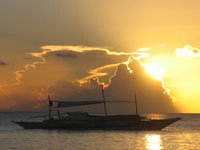
The Philippines may soon outpace India as the leader in the multi-billion dollar global business process and IT services outsourcing industry as India faces serious challenges that are threatening its leadership position and opening the door wider for alternative locations such as the Philippines – Philippine Star, Dec. 26, 2004
The articles goes on about the Philippines’ strong points and high possibility of turning this prediction into a reality, citing significant share in the world’s contact center jobs. It also pointed out the Philippines aggressiveness, attracting 70 contact center firms and expecting it to grow to 130 in 2005.
In a country recently plagued by calamities left and right, with its reputation tarnished by its corrupt government as well as a sinking economy, this news is undeniably one of the very few good things going on in the country right now. The call center industry has already employed roughly 40,000 of our English speaking countrymen and it is predicted that 300,000 more seats are to be generated in the coming years. Anyone who knows about the alarming unemployment and poverty rate in this country may very well think that this is a glimmer of hope for the Filipino.
But before we start lighting fireworks and rejoicing, I can tell anyone right now that the call center is not for everybody. I personally have hands on experience in this area, from a front liner agent, to trainer, to one with management powers. Being an early player in the game, I’ve seen people come and go, succeed and fail, move on, fight back or give up. I’ve seen aspirants go home disappointed after grueling tests and interviews, asking themselves, “What is it that they want that I don’t have?”
Well buddy, your English isn’t up to par. You’ve spent too many hours watching Eat Bulaga, reading aliwan komiks and listening to Parokya ni Edgar. Don’t get me wrong. These are all part of me growing up too. But to the average Filipino, it is what he eats, drinks and breathes. This kind of person ends up disliking English and thus is unable to speak it decently.
The call centers want people who are not ashamed of speaking perfect English as opposed to the common Filipino who burst into laughter at the first utterance of “hey!”
Call centers want people who are open to learning and striving for excellence as opposed to those who are smart aleck type asses at the corner store.
In this regard, there might not be enough qualified manpower to fill up the predicted 300,000 positions. Already, in most call centers, the passing rate for applicants is just a disappointing 2%. Those who graduated from the more reputable schools end up getting hired. But before we start the “It’s because they are richer” bitching attitude, think about this. The better schools have been more supportive of an English speaking environment. These schools encourage their students to express themselves in English and even in other foreign languages. Also, these kids’ parents have been supportive in this area. On the other hand, elsewhere, children who show promise of excelling in English have been the butt of jokes and are even ostracized by their peers. They are even accused of being un-nationalistic- when anyone in his right mind knows that people who make these accusations are those who suck and it is their defense mechanism to despise English.
Recently, the country has been alarmed by the steadily dropping rate of English proficiency among Filipinos. Countless forums and debates have been held about this matter.
I was watching a debate show about this topic and the participants were divided into two sides- those who think that the English level of Filipinos has gone down the drain and those who don’t.
I personally agree with the former and I’m furious at the latter.
Here are some key points by the opposition.
Our English hasn’t gone down the drain because:
- Our contact center industry is alive and healthy
- Our nurses and other professionals are still in demand over other countries because of our English edge.
- The Japanese and Chinese are successful even though their English sucks.
- Other nationalities, mainly Koreans and Japanese come to the Philippines to study
- (One actress said) “You don’t need English to succeed in a business in your hometown.”
Had I been at the studio myself, I would have thrown back at them:
- The talent pool for the call centers is nearing saturation point. At the recent job fair, many were turned away because they simply can’t speak English decently.
- Our nurse and other professionals are required to take the TOEFL/ IELTS, exams that measure the English proficiency level of those from non-English speaking country. This is insulting given the fact that we are the world’s third largest English speaking country. If the common Filipino is sooo good in English, why do we still have to take the damn tests?
- East Asians- the Chinese, Japanese and Koreans are recognizing the importance of English for global competence. All people from all walks of life from 7 – 77 years old pay large amounts of money to tutors and teacher just so they can learn English. They even invite Americans, Canadians, English and Australians to work in their countries, teaching English. We on the other hand have all the resources and dismiss English as a sign of lost nationalism.
- Koreans and Japanese come here to study English because it is the cheapest and nearest foreign country to study English in. Those who come here can’t afford to go to the US, Canada, etc. Many would rather go to South Africa. Teachers and tutors are paid a sorry 40 pesos an hour.
- Commenting on that actress’s statement will only lower my IQ. Go figure.
As a response to the news of Filipinos English level dropping, some universities have implemented measures in their own campuses to encourage the use of English. Even the president has issued a directive to return to English as the official medium of instruction. In spite of these, at the end of the day, true excellence will still come from each individual, with a real desire to learn and be fluent in this controversial language. A change in attitude will also do the trick. Being fluent in a foreign language does not diminish one’s love of country. It rather enriches that love and equips the person to face the world. Besides, by now, English is as Filipino as many of out traditions. It has been a part of our history and a huge part of our character as Filipinos. I’ll never let anyone take that away from me.



 .
.
.jpg)


